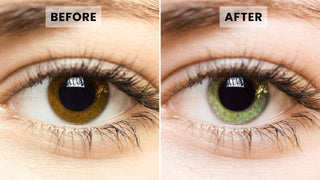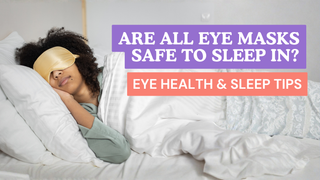Ever looked in the mirror and wished your eyes were a different color? Well, turns out a lot of people do - so much that there’s now technology to achieve a change in eye color permanently, from iris implants to corneal tattooing!
If these sound pretty scary to you, we’re here to tell you that your gut is absolutely right. So, let’s dive into the different procedures that’s currently accessible, what they entail, and if it’s actually safe for your eyes. Read on to get to the bottom of this eye-catching topic:
Iris Implant Surgery
Is there really a surgery to change eye color? Apparently - yes.
Iris implants are a type of surgical procedure that claim to have permanent effects. During the process, a small, colored silicone disc is inserted into the eye to cover the natural iris, which can give the appearance of a new eye color.
But, these implants are not widely accepted within the medical community due to their potential risks and complications, including corneal damage, glaucoma, and inflammation. What’s more, there’s also limited knowledge on the long-term effects of the procedure, which is why many eye doctors advise against the use of iris implants for a change in eye colour. This procedure is currently not approved by the FDA either, so it’s best to listen to the experts and sit this one out.
Stroma Laser System
The Stroma Laser System is a non-invasive medical technology designed to change eye color by reducing the melanin in the iris using a low-energy laser. The procedure involves a 20-second laser treatment per eye, possibly requiring multiple sessions, to fragment the melanin, which the body gradually removes, leading to a lighter eye color over weeks or months. This permanent change aims to offer a non-surgical alternative to eye color alteration, with the technology still undergoing clinical trials and regulatory approval in various countries. While promising for cosmetic and potential medical applications, the long-term safety and efficacy are still being evaluated, necessitating caution and consultation with qualified ophthalmologists before considering the procedure.
Keratopigmentation
Also known as corneal tattooing, Keratopigmentation is a cosmetic procedure that can change your eye color semi-permanently. It entails injecting a small amount of pigment into the cornea (just like getting a tattoo), which essentially gives you a new eye color.
Keratopigmentation is a medical procedure that involves implanting biocompatible pigments into the corneal stroma to alter eye color, either for cosmetic purposes or to address medical conditions like corneal scars, iris defects, or aniridia. The procedure, which uses femtosecond laser technology or manual techniques to place the pigment, offers a permanent change, unlike contact lenses, though it can be adjusted or reversed surgically if needed. While generally safe, with advancements reducing risks, potential complications like infection, inflammation, and vision changes exist, making thorough consultation with an ophthalmologist essential to determine eligibility and expected outcomes.
This procedure was originally used for patients with corneal opacity problems associated with conditions like keratitis or leucoma, but still remains unapproved for purely cosmetic reasons. What’s more, Keratopigmentation could still put you at risk of complications such as light sensitivity, corneal infection, and other ocular injuries too.
Color Changing Eye Drops
You’ve probably seen these all over Instagram: those sponsored influencer posts about eye drops that seem to magically transform your eye color without any side effects? Yup, those are the ones. Well, we hate to break it to you, but they're unlikely to work—and would cost you thousands of dollars worth of bottles before you can allegedly ‘see the effects’.
Color changing eye drops are a relatively new and experimental cosmetic product designed to alter the color of the iris. These drops typically contain specific chemicals or compounds that interact with the melanin in the eye to gradually change its color. The exact mechanism can vary depending on the product and formulation, but they are generally believed to work by either reducing the amount of melanin in the iris or by depositing pigments that alter the eye's appearance.
Unlike surgical options, these eye drops offer a non-invasive method for changing eye color, making them an attractive option for individuals seeking a less drastic approach. Users typically apply the drops regularly over a period of weeks or months to achieve the desired color change. The process is gradual, allowing for monitoring of the change and discontinuation if adverse effects occur.
The permanence of the color change varies. Some products claim to offer a long-lasting change, while others may require ongoing use to maintain the new color. However, the safety and efficacy of color changing eye drops are still under investigation. Potential risks include eye irritation, allergic reactions, and other unknown long-term effects. It is crucial for users to approach these products with caution and ideally consult with an eye care professional before use.
Many of these products are not yet approved by major regulatory bodies like the FDA, meaning their safety and effectiveness have not been thoroughly vetted through standard clinical trials. Consumers should be wary of unverified claims and consider the regulatory status of the product before use. Other options for changing eye color include colored contact lenses, which provide a temporary and reversible change, or surgical procedures like keratopigmentation or the Stroma Laser System for a more permanent solution.
Color changing eye drops represent a novel and potentially convenient way to alter eye color, but due to the lack of comprehensive safety and efficacy data, they should be used with caution and under professional guidance.
Try Colored Contacts Instead
Colored contact lenses give you a whole new look, minus the commitment and risky side effects of change of eye color surgery. The best part? You also get the flexibility of experimenting with different eye colors as much as you want, from the lightest of blues to the most stunning of hazels. And with lenses as natural, lightweight, and comfortable as ours, you might even forget that you’re wearing colored contacts!
Explore our wide range of affordable, trendy, and quality lenses here on EyeCandys and get the eye color of your dreams today.









